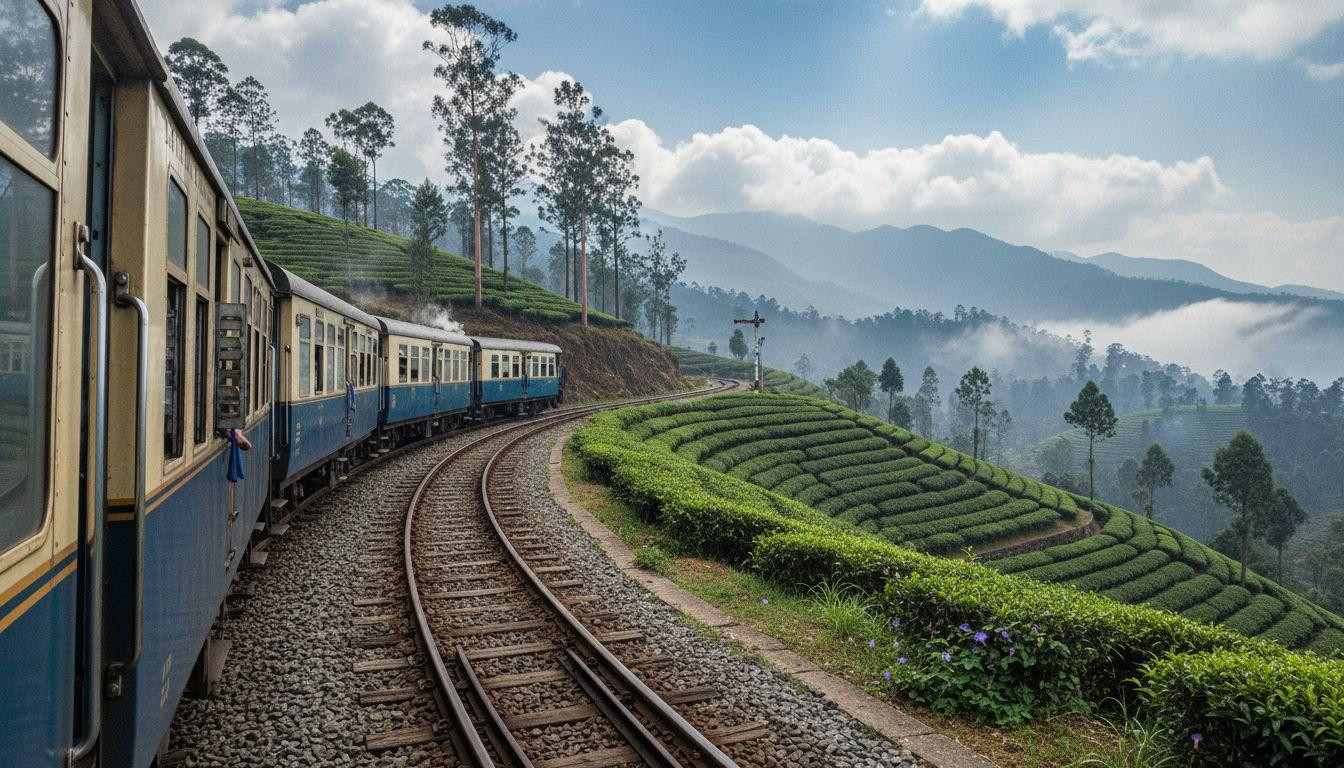Dawn breaks at 6:30 AM over the Nilgiri Hills as morning mist transforms tea estates into layers of emerald shadow. A whistle echoes through the valley at 7:10 AM – the UNESCO toy train beginning its 5-hour climb through clouds at just 6 miles per hour. This is where 735,000 people live inside India’s Blue Mountains and 2 million annual visitors discover what northern hill stations have lost: colonial bungalows without tour buses, rose gardens with 20,000 varieties, and tribal embroidery sold by artisans, not shops. At 7,350 feet, November temperatures hover at 66-68°F while accommodation costs $15-80 per night.
Where mountains turn blue with mystery
The Western Ghats rise like a fortress wall 62 miles east of Coimbatore, their peaks shrouded in the blue haze that gives these mountains their name. Eucalyptus oils evaporate from vast forests, diffracting sunlight into an atmospheric veil that transforms distant ridges into watercolor washes.
Ooty (Udhagamandalam) perches at 7,350 feet, its Victorian architecture testimony to British colonial summers when Chennai’s heat became unbearable. The Nilgiri Biosphere Reserve protects 988 square miles of this landscape, where Tamil Nadu, Kerala, and Karnataka converge.
Coimbatore Airport lies 56 miles away via winding mountain roads. But the real arrival happens aboard the narrow-gauge railway threading through 208 curves and 16 tunnels. This 1908 engineering marvel connects Mettupalayam to Ooty in what feels like time travel through clouds.
The toy train that carries 117 years of stories
UNESCO rails through cloud
First-class tickets cost $7 for the 4-hour 45-minute ascent from Mettupalayam. The rack-and-pinion system grips steep gradients while passengers watch plains give way to tea estates, then pine forests, then cloud. UNESCO recognized this railway in 2005 as World Heritage, but locals knew its magic when British engineers conquered impossible terrain in 1908.
Only 16 first-class seats exist per train, guaranteeing window views as morning light ignites mist over emerald hills. This colonial hill station where British summer palaces rest above pine forests at 7238 feet offers similar toy train experiences, but the Nilgiris remain less crowded.
Victorian stations frozen in time
Coonoor Station, halfway up at 6,070 feet, preserves Art Deco details and hand-painted signs. Steam hisses from vintage engines on heritage runs during peak season. The train crosses girder bridges where valleys drop away into fog.
These moments inspire the Instagram hashtags that went viral in 2025: #NilgiriMornings and #OotyToyTrain. But standing on the platform at dawn, watching mist rise from tea gardens, feels too sacred for social media.
Where tea meets roses meets tribal embroidery
Walking through 20,000 rose varieties
The Government Rose Garden sprawls across 10 acres in Ooty’s heart, cultivating over 20,000 rose bushes representing 2,800 varieties. November blooms paint hillsides in crimson, coral, and cream. Entry costs $3.
Morning light between 6:30-8 AM offers the best photography as mist lifts to reveal layers of color against Victorian greenhouses. The adjacent Botanical Gardens add 1,000 plant species across 55 acres, including fossilized trees 20 million years old. These Blue Mountains share eucalyptus forests with Australia’s namesake range.
Tea estate walks and traditional crafts
Guided tea estate tours cost $10-15 and reveal the process from leaf to cup while mist swirls through terraced plantations. The slow pace allows conversations with workers who’ve picked these slopes for decades.
Local Toda tribal artisans sell intricate embroidery – geometric patterns echoing 2,000 years of mountain culture. These aren’t tourist trinkets but museum-quality textiles priced $15-40. Homestays in Kotagiri ($30-50 per night) offer authentic interactions that big Ooty hotels cannot provide. This mountain town shares similar Art Deco heritage with the Nilgiris’ colonial architecture.
The calm that northern hill stations forgot
Northern hill stations crush millions of tourists into narrow streets. The Nilgiris spread 2 million visitors across three distinct towns – Ooty, Coonoor, and Kotagiri – preserving space to breathe.
Mornings in Coonoor feel like waking inside a cloud. The smell of wet earth and tea leaves mingles with pine. The distant chug of the toy train provides the only mechanical sound. Doddabetta Peak (8,650 feet, highest point) offers panoramic silence at sunrise.
This isn’t escape from India but immersion in what hill stations were meant to be: cool air, mountain calm, and time that moves at cloud speed. Better than overcrowded destinations, the Nilgiris remain authentically unhurried.
Your questions about Nilgiri Hills, India answered
When should I visit and what will it cost?
November-March offers ideal conditions: 59-77°F days, minimal rain, clear mountain views. Budget $50-80 daily for comfortable mid-range travel. Accommodation ranges from $15-25 guesthouses to $100-150 heritage hotels.
The toy train ($7), botanical gardens ($3), and tea tastings ($10-15) keep daily costs reasonable. Meals at local eateries cost $3-7. November sees moderate crowds, perfect for serene exploration.
How do I get there from major Indian cities?
Coimbatore International Airport offers closest access with domestic flights from Delhi ($60-80) or Mumbai ($50-70). Taxis cost $40-70 for the 3-hour mountain drive to Ooty.
Alternatively, take the scenic toy train from Mettupalayam near Coimbatore. Book 60 days ahead as first-class seats (16 per train) sell out quickly. The journey becomes part of the destination.
Is it really less crowded than Shimla or Darjeeling?
Yes. Tamil Nadu tourism data shows the Nilgiris welcome 2 million visitors annually across three towns, while northern hill stations concentrate similar numbers in smaller areas. November weekdays feel genuinely tranquil.
Accommodation costs 15-30% less than comparable northern hill stations. The colonial architecture rivals Shimla’s, but without the crushing crowds on mall roads. Tea estates remain working landscapes, not tourist attractions.
As evening mist rolls through valleys, Ooty’s lights begin to glow – terracotta roofs against darkening pine. The toy train whistles one last time before sunset. Tomorrow, mountains will turn blue again, tea estates will emerge from cloud, and 1908 will feel like yesterday.
